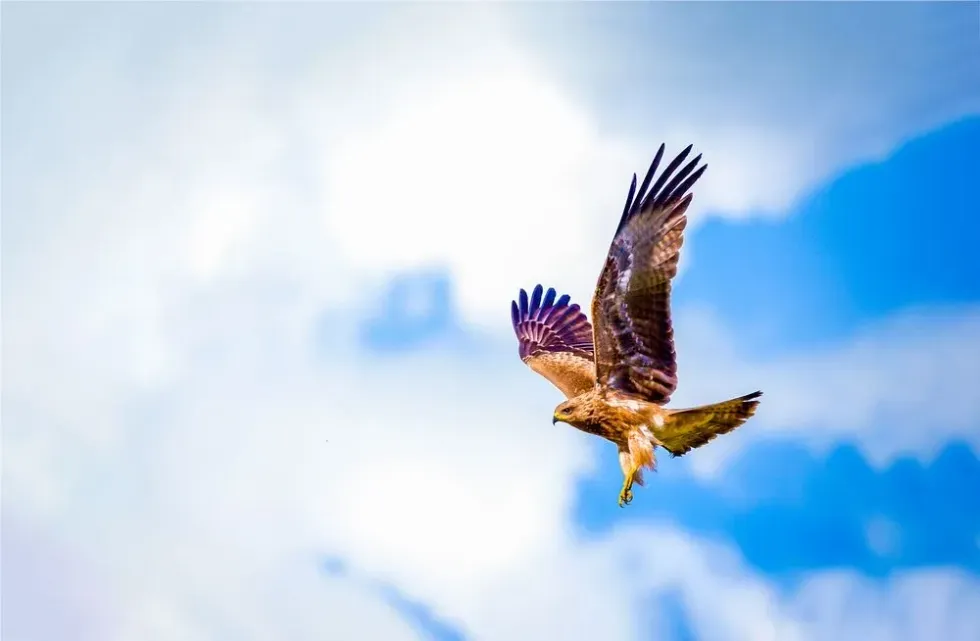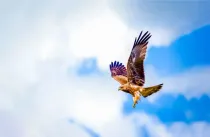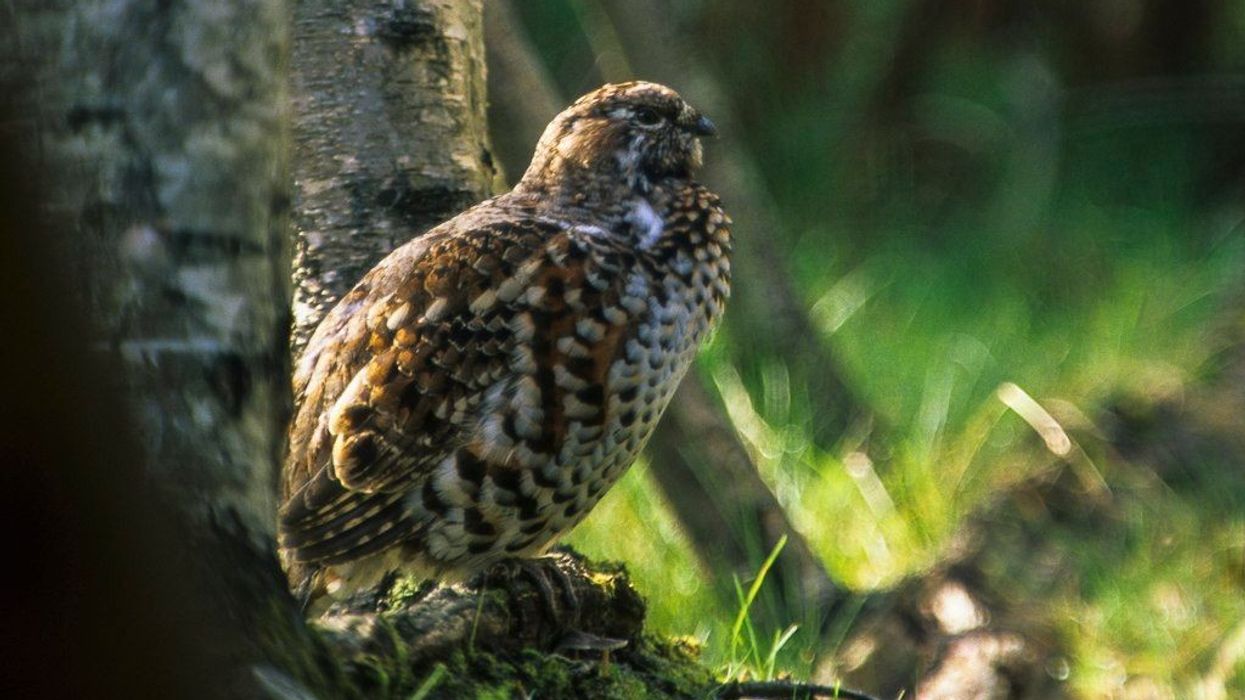Hawks are predatory birds that have a medium size and have a sharp beak and talons for the purpose of hunting. Hawks are divided into over 50 species.
These birds, while very different from eagles and owls in some ways, are still related to them. Some species of hawks are the sharp-shinned hawk, Harris' hawk, Cooper's hawk, red-tailed hawk and the European sparrow hawk. Out of these, the red-tailed hawk, found in North America, is the one known by most people.
Hawks may spot prey from almost 100 ft (30 m) away and fly at great heights. This predator of the Accipitridae family likes preying on animals like rabbits, fish, and snakes.
The hawk is known for being powerful and strong with amazing eyesight and curved talons. They are incredibly smart and can see eight times better than humans.
These combined with their majestic looks make them very special birds. However, you shouldn't keep them in your backyard as these wild beasts might not be used to a tame life. Read on for hawks facts.
If you enjoy reading about hawks, you will also enjoy kakapo and Spix's macaw.
Hawk Interesting Facts
What type of animal are hawks?
The hawks are a type of bird.
What class of animal do hawks belong to?
Hawks belong to the class Aves.
How many hawks are there in the world?
According to reports, there are almost 200 species of hawks with almost 25 of these in the United States itself.
Where do hawks live?
Hawks prefer tropical and temperate climate regions and are found in deserts, lakes, meadows, rainforests, and cities.
What is a hawk's habitat?
Apart from the polar regions, hawks can be found in almost every habitat on the planet. They can be found in both wet tropical and dry arid conditions.
Hawks are also abundantly found in the temperate region, living through hot summers and cold winters. They hunt in almost all types of land including marshes, meadows, deserts, rainforests, forests, lakes, and prairies. There are some species that prefer living in urban areas and can be spotted on farms and in cities.
Who do hawks live with?
The vast majority of hawks are solitary, though some species congregate in small groups known as a boil or a kettle. Some species are monogamous, with mated couples remaining together for the rest of their lives. However, these pairs are territorial and not social with other species or other hawks of the same species.
How long do hawks live?
In the wild, hawks tend to live around 10-20 years while they survive much longer in captivity. Their average lifespan in captivity is 20 years while some have even lived up to 30 years.
How do they reproduce?
The reproductive strategies and rates of these birds vary depending on the species. Hawks are monogamous for the most part, either for the whole year or for the remainder of their lives. They stay with only one partner for one or more breeding seasons.
The hawk's mode of reproduction differs from that of most other birds. In a circular motion, the male and female will fly together.
The male will dive toward the female until they reach a certain height, and then they will rise up to that height. The two birds will keep doing this until the male catches up to the female and the two of them start free-falling to the earth.
Incubation lasts about a month, and females lay about one to five eggs at a time.
For around a month, both the male and female will set up the hawks' nest and cater to and care for the eggs before they hatch. Young hawks begin flying and hunting when they are around six weeks of age or more, depending on the species.
What is their conservation status?
According to the International Union of Conservation of Nature, the hawk's conservation status is Least Concern for maximum of its species. There are many species of hawks all over the world.
They are not extinct and exist in huge numbers all over the world. However, different species of third bird have different numbers with some, such as the Ridgway's hawk, even being critically endangered.
Hawk Fun Facts
What do hawks look like?
This bird comes in a range of sizes and feathers or plumage, depending on the species. They have curved beaks, long tails, and edged talons. Their colors and patterns vary greatly, with some birds being completely colorless to having brownish or reddish-brown colors, and others having markings or bands. Hawks have large eyes, but not as large as owls'.
How cute are they?
Hawks birds are not considered cute but are considered very regal and handsome. With classic feathers or plumage, incredible eyesight, and a long wingspan, they are considered as one of the most good-looking birds.
How do they communicate?
Hawks belong to many different families, but their communication methods are identical. They often scream or screech all day to indicate different issues. To signal the presence of tall trees in the forest, these birds make wheeling and whistling sounds.
They may also whistle to indicate the presence of water. The birds chase their prey from great heights in the sky, and they use sound to locate and judge the distance between them and their prey.
The 'kee-ahh' with a sharp ending is an example of such a tone. Another is a long whistle, which is used to assert and warn other birds of one's territory. Females make the soft 'kee' sound the most, particularly when on the nest.
How big is a hawk?
Hawks are medium-sized birds. Due to their varied number of species, hawks vary in shapes and sizes too.
Some small hawks like the little sparrow hawk has a length of about 7.9-9.8 in (20-25 cm) while the northern goshawk species tend to be much larger, at almost 27 in (69 cm). The most common hawk, the red-tailed hawks, are about 18-25 in (45-65 cm) in length.
How fast can hawks fly?
Hawks can fly at speeds ranging from 22-28 mph (35-45 kph). According to research done with red-tailed hawks, it flies at a speed of 20-40 mph (32-64 kph).
At 60 mph (96 kph), the peregrine falcon is a little quicker. When hawks dive down to capture prey, spotting them even if they are 100 ft (30 m) away, they attain a more impressive pace.
The red-tailed hawk has the ability to dive at an impressive speed of 120 mph (190 kph). On the other hand, the peregrine falcon reaches speeds of up to 150 mph (241 kph).
How much do hawks weigh?
The weight of hawks differs from one species to another. For example, the red-tailed hawk weighs 2.4 lb (1.1 kg) while the sharp-shinned hawk weighs 0.3-0.5 lb (150-220 g), Common Buzzard 0.9-3.1 lb (0.4-1.4 kg), Northern Goshawk 1.4-3.1 pounds (0.6-1.4 kg), and the Black Kite 1.6 lb (730 g).
What are their male and female names of the species?
A male hawk is known as a tiercel while a female hawk is known as a hen.
What would you call a baby hawk?
A baby hawk who is too small and stays in its nest is known as an eyas.
What do they eat?
Hawks are obligate carnivores since they are birds of prey. This means the hawks' diets consist of only meat and they do not touch plants.
These birds consume a large range of prey due to their varied habitats. They spot their meal from far away, dive in, and kill them with their talons.
Small mammals and reptiles like snakes, rabbits, mice, rats, lizards, squirrels, birds, fish, and anything small are all targets of the hawk. Hawks do kill cats and dogs but sometimes they cannot carry them off after killing.
They do not pick up any weight more than their own. Some animals will hunt everything they can get their hands on, while others are particular and picky about their prey.
Are they dangerous?
The hawk has gained its reputation as one of the most dangerous birds thanks to its keen eyesight and razor-sharp claws. Puppies and other small pets have been recorded to be picked up by falcons on several occasions.
A typical hawk meal, on the other hand, includes small mammals and reptiles like snakes, lizards, fish, mice, rabbits, and other small birds. Hawks are thought to be among the smartest animals, and they kill with their claws.
Would they make a good pet?
Hawks are not suitable as pets. They need a large amount of area to fly and an ample supply of fresh meat for meals. In a household environment, it is incredibly difficult to adequately care for them. You'll also find it difficult to obtain the requisite permits to hold a hawk as a pet.
Did you know...
Hawks are diurnal birds. The word diurnal means 'active in daytime', which means these predatory birds go hunting during the daytime.
What animal eats hawks?
Eagles, owls, and crows are the main predators for hawks, making the hawk afraid of them. Eagles are the top predators of hawks, preying on them for food. For sport, crows and owls prey on and harass hawks. If they get the opportunity, raccoons and snakes will steal eggs from hawk nests. Hawks also fight amongst themselves over territory.
What is a hawk's wingspan?
A hawk's wingspan differs from one species to the other.
For example, the wingspan of a red-tailed hawk is about 39.4-59.1 ins (1-1.5 m ), sharp-shinned hawk is 22.8-26.8 in (58-68 cm), Common Buzzard 43.3-55.1 in (1.1-1.4 m), Black Sparrow hawk 30.3-39.4 in (77-100 cm), Grey Goshawk 27.5-43.3 in (70-110 cm), and the Red-necked Falcon is 33.5 in (85 cm).
Here at Kidadl, we have carefully created lots of interesting family-friendly animal facts for everyone to discover! Learn more about some other birds including crowned eagle, or American kestrel.
You can even occupy yourself at home by drawing one on our hawk coloring pages.










